Buick Riviera
| Buick Riviera | |
|---|---|
 1963 Buick Riviera | |
| Overview | |
| Manufacturer | Buick (General Motors) |
| Model years |
1963–1993 1995–1999 |
| Body and chassis | |
| Class | Personal luxury car |
| Chronology | |
| Predecessor | Buick Super |
The Buick Riviera is a personal luxury car produced by Buick from 1963 to 1999. GM's first entry into that prestige niche, the Riviera was highly praised by automotive journalists upon its high-profile debut. While early models stayed close to the original form, subsequent generations varied substantially over the Riviera's thirty-year lifespan. In all, 1,127,261 were produced.
Unlike its contemporary GM E platform stablemates, the Oldsmobile Toronado and Cadillac Eldorado, the Riviera became front wheel drive starting in 1979.
The Riviera name has been given to concept cars displayed at auto shows in 2007 and 2013 in hopes of resurrecting the marque, but no plans to do so are currently in place.
Origins
The Riviera name

The name Riviera, Latin for coastline, was chosen to evoke the allure and affluence of the French Riviera. It first entered the Buick line in 1949, as the designation for the new two-door pillarless hardtop, described in advertising as "stunningly smart". The Buick Roadmaster Riviera coupe (along with the Cadillac Coupe de Ville and Oldsmobile 98 Holiday coupe) constituted the first mass production use of this body style, which was to become extremely popular over the next 30 years. Buick added a two-door Riviera hardtop to the Super the following year, the Special in 1951 and the Century upon its return, after a 12-year absence, in 1954.
From 1951 to 1953 the Riviera designation was given to the existing long wheelbase versions of the four-door Buick Roadmaster and Super sedans. The 1951–53 Buick Roadmaster and Super four-door Riviera sedans feature more standard features, more plush interior trim and, most significantly, a wheelbase (and overall length) that is 4 inches (102 mm) longer than a regular Buick Roadmaster or Super four-door sedan. The 1951–52 Buick Super four-door Riviera sedan is still 0.75 inches (19 mm) shorter in wheelbase and length than the regular Buick Roadmaster and 4.75 inches (121 mm) shorter than the Roadmaster four-door Riviera sedan. In 1953, with the move from the Fireball straight-eight to the more compact Nailhead V8 engine, the Roadmaster and Super four-door Riviera sedans became the same length.
In the middle of the 1955 model year, Buick and Oldsmobile introduced the world's first mass-produced four-door hardtops, with Buick offering it only on the Century and Special models, and the Riviera designation was also applied to these body styles. Four-door Riviera hardtops were added to the Roadmaster and Super lines at the beginning of the following model year. However, since it was a body style designation and not a model, the Riviera name does not usually appear on the car.
In 1959, Buick became much more selective in applying the Riviera name. From then until 1962 it only was used to denote a premium trimmed six-window hardtop style which it initially shared exclusively with Cadillac (the Oldsmobile 98 would receive it in 1961) and was available only on the Electra 225. The last usage of the term Riviera to describe to describe a luxury trim level was 1963, as the formal designation of the #4829 Electra 225 Riviera four-door hardtop, the same year the E-body model two-door hardtop coupe Riviera made its debut.
Debut as a personal luxury car
In the late 1950s, GM lacked a personal luxury car to compete with the highly successful Ford Thunderbird—a uniquely styled, two-door, four-passenger car. To fill this gap, an experimental Cadillac design (the XP-715) was created. Its angular styling was reportedly inspired by GM styling chief Bill Mitchell's visit to London during the period, when he was struck by the sight of an elegant, custom-bodied Rolls Royce. He later said that "knife-edged" styling was what he wanted for the new model, but with a lower profile. The design itself was penned by stylist Ned Nickles.
However, Cadillac management was not particularly interested in such a vehicle and in 1960 the project was thrown open for competition by the other divisions. Buick, desperate to revive its flagging sales, enlisted the aid of the McCann-Erickson advertising agency to create its presentation. Buick won, and the finished design was adapted to a shortened version of Buick's cruciform frame. The design was substantially the same as the original, although the hidden headlights—originally concealed in the fender grilles—were initially omitted for cost reasons. It was introduced as a concept car in 1963 called the Buick Riviera Silver Arrow.[1]
First generation (1963–1965)

| First generation | |
|---|---|
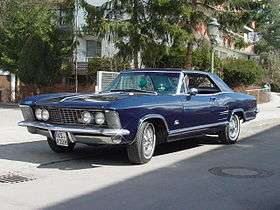 | |
| Overview | |
| Model years | 1963–1965 |
| Assembly |
Buick City, Flint, Michigan Linden, New Jersey (Linden Assembly) United States |
| Body and chassis | |
| Body style | 2-door hardtop |
| Layout | FR layout |
| Platform | E-body |
| Powertrain | |
| Engine |
401 cu in (6.6 L) Nailhead V8 425 cu in (7.0 L) Nailhead V8 |
| Transmission |
Twin Turbine automatic transmission 3-speed ST-400 automatic |
| Dimensions | |
| Wheelbase | 117.0 in (2,972 mm) |
| Length | 208.0 in (5,283 mm)[2] |
| Width | 76.3 in (1,938 mm)–76.6 in (1,946 mm) |
| Height | 53.0 in (1,346 mm) |

The production Riviera's distinctive bodyshell was unique to it, unusual for a GM product. It rode a cruciform frame similar to the standard Buick frame, but shorter and narrower, with a 2.0 in (51 mm) narrower track. Its wheelbase of 117 in (3,000 mm) and overall length of 208 in (5,300 mm) were 6.0 inches (150 mm) and 7.7 in (200 mm) shorter, respectively, than a Buick LeSabre, but slightly longer than a contemporary Thunderbird. At 3,998 lb (1,813 kg),[3]:210 it was about 390 pounds (180 kg) lighter than either. It shared the standard Buick V8 engines, with a displacement of either 401 cu in (6.57 L) or 425 cu in (6.96 l), and the unique continuously variable design twin turbine automatic transmission. Power brakes were standard, using Buick's massive "Al-Fin" (aluminum finned) drums of 12 in (300 mm) diameter. Power steering was standard equipment, with an overall steering ratio of 20.5:1, giving 3.5 turns lock-to-lock.
The Riviera's suspension uses Buick's standard design, with double wishbones front and a live axle located by trailing arms and a lateral track bar, but the roll centers were raised to reduce body lean. Although its coil springs were actually slightly softer than other Buicks, the Riviera's lighter weight made its ride somewhat firmer. While still biased towards understeer, contemporary testers considered it one of the most driveable American cars, with an excellent balance of comfort and agility.
Rather than the "Sweepspear" used on beltlines of earlier Buicks with the Riviera package, the new Rivera sported new "Coke bottle styling", with the middle of the body exhibiting a tapered tucked-in appearance.
The Riviera was introduced on October 4, 1962, as a 1963 model, with the 325 hp (242 kW) 401 cu in (6.6 l) "Nailhead" V-8 as the only available engine,[3]:204 fitted with dual exhaust as standard equipment, and the turbine drive the only transmission,[3]:206 at a base price of $4,333;[3]:210 typical delivered prices with options ran upwards of $5,000. Buick announced in December 1962, the availability of a 340 hp (254 kW) 425 cu in (7.0 l) version of the Nailhead as an option. Total production was deliberately limited to 40,000 vehicles (in a year that Buick sold 440,000 units overall) to emphasize its exclusivity and to increase demand; only 2,601 of them were delivered with the 425 cu in (7.0 l) engine in the 1963 model year.
With the same power as the larger Buicks and less weight, the Riviera had sparkling all-around performance: Motor Trend found it capable of running 0–60 mph (0–97 km/h) in 8 seconds or less, the standing quarter mile in about 16 seconds, and an observed top speed of 115 miles per hour (185 km/h). Fuel economy was a meager 13.2 miles per US gallon (17.8 L/100 km; 15.9 mpg-imp). Front leg room was 40.1 inches.[4]
Inside, the Riviera featured a four-place cabin with front bucket seats separated by a center console with floor shifter and storage compartment that was built into the instrument panel, and bucket-style seats in the rear. Upholstery choices included all-vinyl, cloth and vinyl, or optional leather. A deluxe interior option included real walnut inserts on the doors and below the rear side windows. Popular extra-cost options included a tilt steering wheel, power windows, power driver's seat, air conditioning, a remote-controlled side view mirror, and white sidewall tires.
The Riviera continued with minimal trim changes for 1964 including the discontinuation of leather upholstery from the option list, differing mainly in substitution of the old Dynaflow-based twin turbine for the new three-speed Super Turbine 400. The Super Turbine 400 was marketed as Turbo Hydra-Matic by other GM divisions, but in the Buick version (also used in the 1964 Electra 225) had a variable pitch torque converter like the old twin turbine Dynaflow had. The 1964 version used a two speed "D,L" selector but could automatically downshift from third to second until the car reached a suitable speed to downshift to first. This was the first year that the Stylized "R" emblem was used on the Riviera, a trademark that would continue throughout the remainder of Riviera's 36-year production run. Under the hood, the 401 cu in (6.6 l) was dropped as the standard power plant in favor of the previously optional 340 hp (254 kW) 425 cu in (7.0 l) V8. A 'Super Wildcat' version was optionally available, with dual Carter AFB four-barrel carburetors, rated at 360 hp (268 kW).
Changes for 1965 included the introduction of the "Gran Sport" option, which included the dual-quad Super Wildcat 425 V8, a numerically higher 3.42 axle ratio, and stiffer, heavy-duty suspension. The stock dual exhaust pipes were increased from 2.0 inches (51 mm) to 2.25 inches (57 mm) inside diameter and had fewer turns to reduce backpressure. The 401 cu in (6.6 l) V8 returned as the standard Riviera engine and the Super Turbine 400 transmission retained the variable pitch torque converter, but was fitted with a three-speed gear selector. Externally, the headlamps were concealed behind clamshell doors in the leading edges of each fender, as in the original design. Further back, the non-functional side scoops between the doors and rear wheel arches were removed, and the taillights were moved from the body into the rear bumper.[5] A vinyl roof became available as an option, initially offered only in black, and the tilt steering wheel optional in previous years was now standard equipment.
Total sales for the three model years was a respectable 112,244. All in all, the Riviera was extremely well received and considered a great success, giving the Thunderbird its first real competition.
The 1963–1965 Riviera met with approval from all quarters, and has since earned Milestone status from the Milestone Car Society. Jaguar founder and designer Sir William Lyons said that Mitchell had done "a very wonderful job," and Sergio Pininfarina declared it "one of the most beautiful American cars ever built; it has marked a very impressive return to simplicity of American car design." At its debut at the Paris Auto Show, Raymond Loewy said the Riviera was the handsomest American production car—apart from his own Studebaker Avanti, that is, the Riviera's only real competition for 1963.[6] The first-generation Riviera is considered a styling landmark, and is quite collectible today.[7]
Second generation (1966–1970)
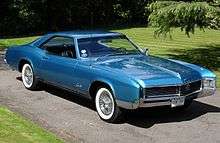
| Second generation | |
|---|---|
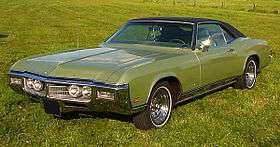 | |
| Overview | |
| Model years | 1966–1970 |
| Assembly |
Flint, Michigan Linden, New Jersey (Linden Assembly) United States |
| Body and chassis | |
| Body style | 2-door hardtop |
| Layout | FR layout |
| Platform | E-body |
| Related |
Cadillac Eldorado Oldsmobile Toronado |
| Powertrain | |
| Engine |
425 cu in (7.0 L) Nailhead V8 430 cu in (7.0 L) Buick V8 455 cu in (7.5 L) Buick V8 |
| Transmission | 3-speed ST-400 automatic |
| Dimensions | |
| Wheelbase | 119.0 in (3,023 mm)[8] |
| Length |
211.2 in (5,364 mm) (1966–67)[9] 215.2 in (5,466 mm) (1968–1970) |
| Width |
78.8 in (2,002 mm) 79.3 in (2,014 mm) (1970) |
| Height | 53.2 in (1,351 mm)–53.6 in (1,361 mm) |
The Riviera was redesigned for the 1966 model year. It retained its cruciform frame, powertrain, and brakes, but it wore a longer, wider, more curvaceous body that modernized the "sweepspear" inspired beltline introduced in the previous generation. This generation shared its platform with the Oldsmobile Toronado, and, a year later, with the Cadillac Eldorado. A notable styling point was the absence of vent windows, a feature GM had introduced with a flourish in the 1930s. Headlamps remained concealed, but they now pivoted up above the grille when not in use. Unlike the Toronado and Eldorado, the Riviera retained a conventional rear wheel drive layout. It was now some 200 pounds (91 kg) heavier, so acceleration with the unchanged 425 engine was slightly slower. The Gran Sport package remained available as an option. Rear seat belts[10] and AM/FM radio[11] were optional.
Inside, the four-place cabin with front and rear bucket seats and center console was replaced by a choice of bucket seats or conventional bench seats as standard equipment, making the Riviera a full six-passenger car for the first time. Optionally available was a Strato-bench seat with armrest or Strato bucket seats with either a short consolette or a full-length operating console with a "horseshoe" shaped floor shifter and storage compartment. Both the buckets and Strato-bench seat were available with a reclining seat option for the passenger's side. Sales for 1966 rebounded to 45,308, a new record.
The most significant change for 1967 was the adoption of Buick's entirely new V8 of 430 cu in (7.0 L) displacement, 360 horsepower (270 kW) and 475 lb·ft (644 N·m) of torque to replace the old 425 "nailhead". The new engine, with greater power and torque on hand, represented a significant performance improvement. Gasoline mileage improved slightly with the new engine, though it remained gas-thirsty compared to modern cars. Powerful disc brakes with Bendix four-piston calipers became optional for the front wheels but most Riviera continued to be ordered with Buick's aluminum brake drums which were almost as good. Cosmetically, changes were few, and were limited to the addition of a wide, full-width, center-mounted horizontal chrome grille bar that stretched over the headlight doors and outboard parking lights. Sales eased to 42,799 for the 1967 model year. The Riviera had full instrumentation.[12]
1967 saw the introduction of U.S. mandated safety equipment to improve occupant protection during a crash, including an energy-absorbing steering column, non-protruding control knobs, 4-way hazard flasher, soft interior surfaces, locking seat backs (on 2-door models), a dual-circuit hydraulic braking system (with warning light), and shoulder belt anchors. Of course Rivieras complied on all counts and featured the full range of safety features.
1968 models had reshaped front and rear loop-type bumpers that encased the vehicle's (recessed crosshatch) grille and tail lamps, respectively. Hidden wiper arms were also new. Federally mandated side marker lights were of an inverted trapezoidal shape on the lower leading edges of the front fenders. Rear marker lights were circular. The interior was restyled and, unlike the 1966–67 models, shared its instrument panel with the other full-size Buick models. Shoulder belts for front outboard occupants were made standard on all cars built from January 1, 1968. There were very few mechanical changes in 1968 but the transmission lost its variable pitch torque converter. Sales set another new record in 1968, as 49,284 units were sold.
For 1969, minor styling changes took place. Grilles changed from the crosshatch pattern seen in '68 to a pattern of finely spaced, slim vertical bars overlaid by two wider horizontal bars, which jutted forward at their inboard edges. Front marker lights became far shorter, and square in shape. Inside, front outboard passengers got new headrests. The ignition switch was moved from the instrument panel to the steering column, and it now locked the steering wheel and selector lever when the key was removed (This feature became mandatory for the 1970 model year). Chrome side trim was revised, as well. At the rear, the reverse lights were move from the rear bumper into the '69 Riviera's new 3-section tail light lenses. Sales for 1969 improved again, to 52,872. A new front suspension system was used.[13]
The 1970 Riviera was restyled. Exposed quad headlamps were nearly flush-mounted, while the new front bumper wrapped around and over the new vertical bar grille, set between the headlamp pods. A newly optional side trim feature accented the large coupe's flowing lines. Skirted rear wheels became standard, with exposed wheels an option. At the rear, a new rear bumper/taillight motif was seen. The engine was upgraded to 455 cu in (7.46 L), the largest engine Buick offered to date, rated at 370 horsepower (280 kW) gross, 245 hp (183 kW) net, and over 500 lb·ft (680 N·m) of torque. Despite the fact that '70 sales dropped to 37,366, the second-generation Riviera proved more successful than the first, with 227,669 units sold over five seasons.
Third generation (1971–1973)
| Third generation | |
|---|---|
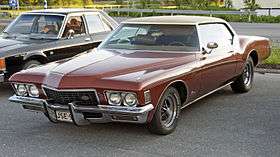 | |
| Overview | |
| Model years | 1971–1973 |
| Assembly |
Flint, Michigan Linden, New Jersey (Linden Assembly) United States |
| Body and chassis | |
| Body style | 2-door hardtop |
| Layout | FR layout |
| Platform | E-body |
| Related |
Cadillac Eldorado Oldsmobile Toronado |
| Powertrain | |
| Engine | 455 cu in (7.5 L) Buick V8 |
| Transmission | 3-speed ST-400 automatic |
| Dimensions | |
| Wheelbase | 122.0 in (3,099 mm)[14] |
| Length |
217.4 in (5,522 mm) (1971) 218.3 in (5,545 mm) (1972) 223.4 in (5,674 mm) (1973) |
| Width | 79.9 in (2,029 mm) |
| Height | 54.0 in (1,372 mm) |
| Curb weight | 4,247 lb (1,926 kg) |

The Riviera was radically redesigned for the 1971 model year with flowing and dramatic "boat-tail" styling.[15] Designed under Bill Mitchell's direction, it was penned by Jerry Hirshberg, future head of design for Nissan, mating the two-piece vee-butted[3]:792 fastback rear window, inspired by the 1963 Corvette Sting Ray split window coupe, to the Riviera's platform.
The design was originally intended for the smaller GM A platform, and the use of the Riviera's body—expanded for 1971 by 3 in (76 mm) in wheelbase and more than 120 lb (54 kg) heavier—produced controversial looks. (Collectible Automobile ran an article about 1971–76 full-sized Buicks in which one sketch design for their 2-door coupes which was rejected resembled the 1971–73 Riviera).
This generation introduced a much more visual representation of the "sweepspear", with a more faithful representation to the version that appeared on 1950s Buicks in both the side molding and beltline.
The 455 engine had a lower compression ratio to meet EPA emissions requirements, reducing power to 255 hp (190 kW), with 265 hp (198 kW) in the Gran Sport. Performance remained reasonably brisk, with a 0–60 time of 8.1 seconds for the GS, but the Riviera's sporty image was rapidly fading. One noteworthy advance was Buick's Max Trac, a traction control system that prevented wheelspin during acceleration on slippery surfaces.[16] The 1971 Riviera also features GM's "Full-Flo" ventilation system and two large deck lid louvers are prominent on the trunk lid. (Unfortunately, under certain conditions a vacuum was created that sucked rain and exhaust back into the car and the "Full-Flo" ventilation was redesigned and the louvers were removed from trunk lid for the 1972 model year.)
Despite these features, Riviera sales for 1971 dropped to 33,810,[3]:798 the lowest to date. The 1972 Riviera was little changed, with the 455 engine switching to net power ratings, 225 hp (168 kW) or 250 hp (190 kW) with the Gran Sport, although the actual drop in net power was only 5 hp (3.7 kW). Sales remained moribund at 33,728.[3]:876 For 1973, the 250 hp (186 kW) engine became standard, with 260 hp (190 kW) with the Stage One package, which also included a limited slip differential and a chrome-plated air cleaner. The "Gran Sport" package was still available as a separate option package consisting of a ride-and-handling package that included a rear stabilizer bar, JR78-15 whitewall steel-belted radial tires, a specially tuned "radial roadability" suspension, additional sound insulation and special "Gran Sport" badging. Sluggish sales of the third generation Riviera led GM to believe that the boattail deck lid was too radical for most customers' tastes, so in 1973 it was blunted and made slightly shorter. The design change however only led to a marginal increase in sales, with 34,080 being produced for the model year.
Fourth generation (1974–1976)
| Fourth generation | |
|---|---|
.jpg) | |
| Overview | |
| Model years | 1974–1976 |
| Assembly |
Flint, Michigan Linden, New Jersey (Linden Assembly) United States |
| Body and chassis | |
| Body style | 2-door coupe |
| Layout | FR layout |
| Platform | E-body |
| Related |
Cadillac Eldorado Oldsmobile Toronado |
| Powertrain | |
| Engine | 455 cu in (7.5 L) Buick V8 |
| Transmission | 3-speed ST-400 automatic |
| Dimensions | |
| Wheelbase | 122.0 in (3,099 mm) |
| Length |
226.4 in (5,751 mm) (1974) 223.0 in (5,664 mm) (1975) |
| Width | 80.0 in (2,032 mm) |
| Height | 54.0 in (1,372 mm) |
Although carrying over the same platform, mechanicals, and some body panels seen on the "Third Generation" Riviera, Buick replaced its distinctive 'boat tail' roofline with a more conventional-looking "Colonnade" treatment. This turned the car from a hardtop coupe into a pillared coupe, as it featured wide B pillars and fixed quarter opera windows. A landau half-vinyl roof option was available. The car did retain its forward-jutting grille, albeit in slightly modified form. Thus modified, the car looked far less distinctive than its predecessors, and even its platform mates, the Oldsmobile Toronado and Cadillac Eldorado. The tamer-looking Riviera was no lighter, and its standard 455 V8 lost more power, dropping to 230 hp (172 kW) and 245 hp (183 kW) for standard and Stage One models, respectively. Max Trac was dropped from the option list after 1974 due to lack of buyer interest. The revised styling did nothing for sales, which plummeted to 20,129 in 1974. This generation introduced as a novelty what later became a federal mandate in a modified form, two high-mounted taillights above the trunk and below the rear window, which was shared on its platform twin the Toronado.
For 1975, the Riviera received an updated front fascia, which lost its forward-jutting theme through the redesign of the fiberglass front end cap. Quad rectangular headlights were mounted horizontally. The new vertical-bar grille echoed the "stand-up" theme that many GM cars of the day incorporated. Parking lights wrapped around the fender sides. The Stage One performance package was dropped for 1975, though the Gran Sport handling package would continue to be offered. The standard engine's output dipped to 205 hp (153 kW). Sales for 1975 were 17,306.
Minor changes greeted 1976 models, the most notable of which was a new crosshatch grille insert. The Gran Sport handling package was replaced by an 'S/R' package that had similar sporting pretensions. Sales rallied slightly to 20,082 for 1976.[17]
Fifth generation (1977–1978)
| Fifth generation | |
|---|---|
 | |
| Overview | |
| Model years | 1977–1978 |
| Assembly |
Flint, Michigan Linden, New Jersey (Linden Assembly) United States |
| Body and chassis | |
| Body style | 2-door coupe |
| Layout | FR layout |
| Platform | B-body |
| Related |
Buick LeSabre Buick Estate Chevrolet Caprice Chevrolet Impala Oldsmobile 88 Oldsmobile Custom Cruiser Pontiac Bonneville/Parisienne Pontiac Catalina/Laurentian |
| Powertrain | |
| Engine |
350 cu in (5.7 L) Buick V8 403 cu in (6.6 L) Oldsmobile V8 |
| Transmission | 3-speed TH-400 automatic |
| Dimensions | |
| Wheelbase | 115.9 in (2,944 mm) |
| Length | 218.2 in (5,542 mm) |

Buick downsized the Riviera for 1977 onto the new smaller GM B platform. While the other E-bodies were front wheel drive since 1966 (1967 for Cadillac's Eldorado), the Buick E platform used a B-body undercarriage (along with the cruciform frame of pre-1965 GMs for the 1966–70 generation). All B-bodies (including C and D platform GM RWDs) were downsized for the 1977 model year which prompted the short-lived 1977/78 generation.
It was, in most respects, a Buick LeSabre coupe with unique styling (with quarter windows mimicking the 1975–78 Cadillac Eldorado). Unlike its LeSabre counterpart, the front fascia is vertical as opposed to slanted. It was reduced to a wheelbase of 115.9 in (2,940 mm), down 6.1 in (150 mm), and an overall length of 218.2 in (5,540 mm), down 4.8 in (120 mm). Weight dropped some 660 pounds (300 kg). The 455 was gone, replaced by a 350 cu in (5.7 L) Buick V8 engine with 155 hp (116 kW) or Oldsmobile-built 403 cu in (6.60 L) with 185 hp (138 kW). California models had a 170 hp (127 kW) Oldsmobile 350.[18]
Sales were up modestly to 26,138 for 1977 and then fell to 20,535 for 1978,[17] although this was strictly a stopgap model until the all-new E-body cars would be ready for 1979. To date, 1977 and 1978 Rivieras are considered a rare find since it was only produced for two model years on the downsized GM B platform before the 1979 redesign on the FWD E-platform (there are two reasons why the B-platform was used—the existing 1976 B-platform was phased out for the downsized variant where RWD E-platform vehicles were produced on the B-chassis. Buick could have continued production although the frame stamping facilities and undercarriage/chassis components were being retooled in late 1976 for downsized B-platform production where the FWD E-platform did not downsize since they were produced on a separate assembly line.
Also, with Buick dropping its 455 V8 after 1976, continuing the '77–78 Riviera on the old E-body platform would have forced Buick to either downsize its engine compartment to their 350 V8, which was too small and underpowered for a 5,000-pound car—or "import" larger engines from other GM divisions including 400s from Chevrolet and Pontiac, Oldsmobile's 403 or Cadillac's 425—each of which would have limited sales and production as each division gave first priority to its own vehicles before selling engines to other divisions.
75th Anniversary Package
For 1978, a special "LXXV" edition was released to commemorate Buick's 75th anniversary on the market. Production total was 2,889 and included special silver & black paint with gray leather seats with black trim, brushed chrome trim, deep pile carpeting and special LXXV name plates.
Sixth generation (1979–1985)
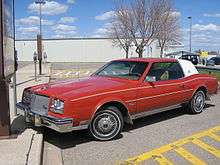
| Sixth generation | |
|---|---|
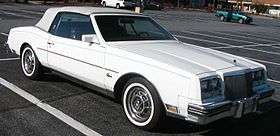 | |
| Overview | |
| Model years | 1979–1985 |
| Assembly |
Doraville Assembly, Doraville, Georgia Flint, Michigan Linden Assembly, Linden, New Jersey United States |
| Body and chassis | |
| Body style |
2-door convertible 2-door coupe |
| Layout | Longitudinal front-engine, front-wheel drive |
| Platform | E-body |
| Related |
Cadillac Eldorado Oldsmobile Toronado |
| Powertrain | |
| Engine |
231 cu in (3.8 L) Buick V6 252 cu in (4.1 L) Buick V6 307 cu in (5.0 L) Oldsmobile V8 350 cu in (5.7 L) Oldsmobile V8 350 cu in (5.7 L) Oldsmobile diesel V8 |
| Transmission |
3-speed TH-325 automatic 4-speed THM325-4L automatic |
| Dimensions | |
| Wheelbase | 114.0 in (2,896 mm)[19] |
| Length | 206.0 in (5,232 mm) |
| Width | 72.8 in (1,849 mm)[20] |

1979 saw the debut of the first front wheel drive Riviera. Built on a trimmer, 114 in (2,900 mm) wheelbase, it once again shared its mechanical design and platform with the Cadillac Eldorado and Oldsmobile Toronado. The Olds 403 and Buick 350 were dropped, but the Olds 350 remained, as did a new turbocharged Buick V6 of 231 cu in (3.8 L) displacement with 185 hp (138 kW). The Riviera became Motor Trend's Car of the Year. Sales more than doubled, to 52,181 for 1979 and 48,621 for the very similar 1980 models.[18]
1981 saw the Turbo renamed T-Type and the demise of the 350 engine in favor of the Oldsmobile-built 307 cu in (5.0 L) with 140 hp (104 kW) (phased in during the 1980 MY). The standard engine was now Buick's 125 hp (93 kW) 252 cu in (4.1 L) V6, and a new option was an Oldsmobile diesel engine with a mere 105 hp (78 kW). offered through 1985. 1982 also saw the first-ever Riviera convertible, although relatively few were built, owing to very high prices-US$23,944. Riviera convertible was available in only two color choices-white or red firemist with the only interior color of red leather. A turbocharged Riviera convertible was chosen to be the pace car at the 1983 Indianapolis 500, although most convertible Rivieras had the V8 engine, which saw an increase in rated SAE net horse power to 150 for both convertibles and coupes fitted with it from 1982 through the 1985 model year.
Overall sales made the 1980s Riviera a great success, reaching 65,305 for the 1985 model year.[17]
Seventh generation (1986–1993)
| Seventh generation | |
|---|---|
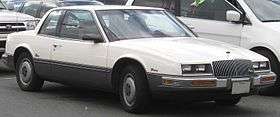 | |
| Overview | |
| Model years | 1986–1993 |
| Assembly | Detroit/Hamtramck Assembly, Michigan, United States |
| Body and chassis | |
| Body style | 2-door coupe |
| Layout | Transverse front-engine, front-wheel drive |
| Platform | E-body |
| Related |
Cadillac Eldorado Oldsmobile Toronado Buick Reatta |
| Powertrain | |
| Engine |
1986–1990: 3.8L 165 hp (123 kW) V6 1991–93: 3.8L 170 hp (130 kW) V6 |
| Transmission | 4-speed THM440-T4 automatic |
| Dimensions | |
| Wheelbase | 108.0 in (2,743 mm) |
| Length | 1986–88: 187.8 in (4,770 mm) |
| Width |
1986–1990: 71.7 in (1,821 mm) 1991–93: 73.1 in (1,857 mm) |
| Height |
1986–88: 53.5 in (1,359 mm) 1989–1990: 53.6 in (1,361 mm) 1991–93: 52.9 in (1,344 mm) |
| Curb weight | 3,309 lb (1,501 kg) |
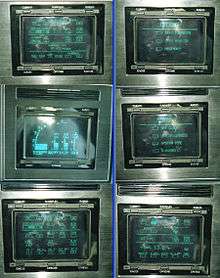
The E-body coupes were converted to unibody construction and further downsized for 1986, to a 108 in (2,700 mm) wheelbase shared with the Buick Regal. The V6 was now the only engine, rated initially at 142 hp (106 kW) SAE and 200 lb·ft (270 N·m) of torque. It used the Turbo-Hydramatic 440-T4 automatic with a 2.84:1 final drive ratio. This generation was noted for advanced electronic instrumentation displayed on a dash-mounted 9-inch (230 mm) CRT. Four-wheel disc brakes were standard. With a choice of three suspension packages available, up to the performance oriented FE3 setting, handling was notably improved. The Riviera placed fourth for Motor Trend's 1986 Car of the Year contest.
Fuel economy was notably improved for the 1986 Riviera, but the investment in the downsized, transverse engine front wheel drive platform resulted in a substantial price increase, to $19,831 to the base model and $21,577 for the new T-Type. Downsizing also resulted in a dimensional similarity to smaller, less expensive offerings from GM, with shared styling cues reinforcing the unfortunate resemblance.

The smaller dimensions, generic styling, and lack of a V8 led to sales plummeting to 22,138 for 1986, only 15,223 for 1987, and a dismal 8,625 for 1988. A restyle for 1989 that added 11 inches (280 mm) to the overall length (on an unchanged wheelbase) helped, but only incrementally, boosting sales to 21,189 for 1989, but dropping to a low of 4,555 for 1993, the shortened final year of that model.[17] The last 1993 Riviera rolled off the Detroit/Hamtramck Assembly plant line on December 10, 1992.
Eighth generation (1995–1999)
| Eighth generation | |
|---|---|
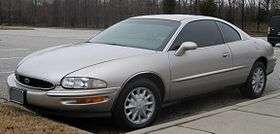 | |
| Overview | |
| Model years | 1995–1999 |
| Assembly | Lake Orion, Michigan, U.S. |
| Designer | William L. Porter |
| Body and chassis | |
| Body style | 2-door coupe |
| Layout | Transverse front-engine, front-wheel drive |
| Platform | G-body |
| Related |
Oldsmobile Aurora Cadillac Seville Buick Park Avenue |
| Powertrain | |
| Engine |
3.8L 205 hp (153 kW) L36 Buick V6 3.8L 225 hp (168 kW) SC L67 Buick V6 3.8L 240 hp (180 kW) SC L67 Buick V6 |
| Transmission |
4-sp auto 4T60E (1995–96 N/A) 4-sp auto 4T60E-HD (1996 Supercharged) 4-sp auto 4T65E-HD (1997–99) |
| Dimensions | |
| Wheelbase | 113.8 in (2,891 mm) |
| Length | 207.0 in (5,258 mm) |
| Width | 75.0 in (1,905 mm) |
| Height | 55.2 in (1,402 mm) |
| Curb weight | 3,788 lb (1,718 kg) |
After a hiatus in 1994, the Riviera returned in 1995 with radical styling that departed from the previous generations' traditional image. A 205 hp (153 kW) naturally aspirated 3800 V6 was standard, with a supercharged version rated at 225 hp (168 kW) and 275 lb·ft (373 N·m) available as an option. Rivieras were now built in Lake Orion, Michigan, riding the same Cadillac-derived G platform as the 4-door Oldsmobile Aurora. The very first of 41,422 Rivieras made in 1995 rolled off the assembly line on May 23, 1994.
In 1996, supercharged versions saw an increase in power to 240 hp (179 kW) and 280 lb·ft (380 N·m), as well as the 4T60E-HD transmission. 18,036 Rivieras were manufactured in 1996.
1997 saw suspension revisions, removing excess weight. An upgraded 4T65E-HD transmission featuring a larger 258 mm (10.2 in) torque converter and heavy-duty gearbox was added. 18,827 were made in 1997.
For 1998, the 240 hp (180 kW) supercharged V6 became standard. GM's OnStar service was added as an option, along with minor interior design changes. 10,953 units were produced for 1998.
With sales of all coupes declining in the North American market, GM decided to discontinue the Riviera. 1999 was the car's last model year with production of 1,956 cars ceasing on November 25, 1998. The final 200 cars had special silver paint and trim, and were denoted "Silver Arrow"[21] models, a designation which hearkened back to several Silver Arrow show cars that had been built off Riviera bodies by Bill Mitchell.
Eighth-generation Rivieras received the most powerful V-6 Buick engine since the Grand Nationals of the 1980s. The supercharged OHV V6 gave impressive torque and acceleration, pushing the car from 0 to 60 miles per hour (97 km/h) in under 7 seconds, and turning the 1⁄4 mile in 15.5 seconds. These numbers, combined with the Riviera's large size and unassuming looks, qualified it as a sleeper, a car with not-so-obvious yet potent performance potential. Additionally, supercharged Rivieras achieved a respectable fuel efficiency figure of 18/27 (city/highway mpg).
Engines
| Model | Year | Engine | Power | Torque |
|---|---|---|---|---|
| Riviera | 1995 | 3.8 L L67 3800 Series I Supercharged V6 | 225 hp (168 kW) @ 5000 rpm | 275 lb·ft (373 N·m) @ 3200 rpm |
| Riviera | 1995–1997 | 3.8 L L36 3800 Series II V6 | 205 hp (153 kW) @ 5200 rpm | 230 lb·ft (310 N·m) @ 4000 rpm |
| Riviera | 1996–1999 | 3.8 L L67 3800 Series II Supercharged V6 | 240 hp (180 kW) @ 5200 rpm | 280 lb·ft (380 N·m) @ 3600 rpm |
Concept cars
2007 concept
| 2007 Concept | |
|---|---|
|
| |
| Body and chassis | |
| Body style | 2-door coupe |
| Dimensions | |
| Wheelbase | 2,870 mm (113.0 in) |
| Length | 4,710 mm (185.4 in) |
| Width | 1,940 mm (76.4 in) |
| Height | 1,415 mm (55.7 in) |
At the 2007 Shanghai Motor Show, Buick debuted a concept coupe named Riviera, based on the GM Epsilon II platform.[22][23] The concept was later shown at the 2008 North American International Auto Show.
It was designed by the Pan Asia Technical Automotive Center (PATAC). The design was inspired by classic Buicks, ancient Chinese artifacts, and modern electronic icons. It includes "icy green" backlighting, Shell Blue body, gull-wing doors, a 2+2 seating configuration, and 21-inch 10-spoke forged aluminum wheels.
2013 concept
| 2013 Concept | |
|---|---|
|
| |
| Body and chassis | |
| Body style | 2-door coupe |
A concept Riviera was also shown at the 2013 Shanghai Motor Show, again developed by the Pan Asia Technical Automotive Center PATAC. It had gull-wing doors and a plug-in electric driveline.[24]
References
- ↑ 1963 Buick Riviera Silver Arrow
- ↑ "1963 Buick Riviera Brochure". Oldcarbrochures.com. p. 16. Retrieved 2012-11-08.
- 1 2 3 4 5 6 7 Flory, J. "Kelly", Jr. (2004), American Cars 1960–1972, Jefferson, North Carolina: McFarland & Coy
- ↑ "1965 Buick Full Line Brochure". Oldcarbrochures.com. pp. 42–43. Archived from the original on March 29, 2013. Retrieved 2012-11-08.
- ↑ "rivowners". Retrieved 2011-09-13.
- ↑ "how stuff works". Retrieved 2011-11-08.
- ↑ "Muscle Car Club". Retrieved 2011-09-13.
- ↑ Ristic-Petrovic, Dusan. "Buick Riviera". Oldcarbrochures.com. pp. 14–15. Retrieved 2012-11-08.
- ↑ "Directory Index: Buick/1966_Buick/1966_Buick_Riviera_Brochure". Oldcarbrochures.com. p. 12. Retrieved 2012-11-08.
- ↑ "Directory Index: Buick/1966_Buick/1966_Buick_Riviera_Brochure". Oldcarbrochures.com. p. 11. Retrieved 2012-11-08.
- ↑ "1967 Buick Riviera Owners Manual". Oldcarbrochures.com. p. 18. Retrieved 2012-11-08.
- ↑ "1967 Buick Riviera Owners Manual". Oldcarbrochures.com. p. 29. Retrieved 2012-11-08.
- ↑ "1969 Buick Brochure". Oldcarbrochures.com. p. 13. Retrieved 2012-11-08.
- ↑ "1971 Buick Riviera Brochure". Oldcarbrochures.com. p. 3. Retrieved 2012-11-08.
- ↑ http://www.musclecarclub.com/musclecars/buick-riviera/images/buick-riviera-1973a.jpg
- ↑ "1971 Buick Riviera Brochure". Oldcarbrochures.com. p. 5. Retrieved 2012-11-08.
- 1 2 3 4 "Riviera Production Numbers". Riviera Owners Association. Archived from the original on 2007-03-07. Retrieved 2007-03-29.
- 1 2 "Evolution of the Riviera". Riviera Owners' Association. Retrieved 2007-02-17.
- ↑ http://oldcarbrochures.org/New-Brochures---September/1984-Buick-Riviera-Brochure-Cdn/1984-Buick-Riviera-Brochure-Cdn--05
- ↑ http://oldcarbrochures.org/New-Brochures---September/1984-Buick-Riviera-Brochure-Cdn/1984-Buick-Riviera-Brochure-Cdn--05
- ↑ Silver Arrow
- ↑ Nunez, Alex (2007-04-14). "Shanghai Motor Show Preview: Buick Riviera Concept". Autoblog.com. Retrieved 2011-09-13.
- ↑ "The Buick Riviera Concept : Car Makes And Models". News.carjunky.com. Retrieved 2011-09-13.
- ↑ Kable, Greg (May 13, 2013). "Best in Show: Buick Riviera". Autoweek. 63 (10): 8.
- Gunnell, John, ed.: Standard Catalog of American Cars: 1946–1975, 4th ed., Iola, Wisconsin: Krause Publications, ISBN 978-0873494618
- Flammang, James M., ed.: Standard Catalog of American Cars: 1976–1999, 3rd ed., Iola, Wisconsin: Krause Publications, ISBN 978-0873417556
- Bastille album, All this Bad Blood: Cover artwork
External links
| Wikimedia Commons has media related to Buick Riviera. |
- Riviera Owners Association—has many helpful links for Riviera information, including more in depth articles on the Riviera History, production figures and dimensions
- Riviera Performance—a discussion board & compilation of Riviera info, mostly focusing on the last generation ('95–99); includes maintenance tips, known issues, FAQ, and write-ups for DIY vehicle improvements
- 1971–1973 Buick Riviera - Boattail—Over 1,700 pictures and lots of information
| Buick, a marque of General Motors, automobile timeline, United States market, 1940s–1970s — next » | ||||||||||||||||||||||||||||||||||
|---|---|---|---|---|---|---|---|---|---|---|---|---|---|---|---|---|---|---|---|---|---|---|---|---|---|---|---|---|---|---|---|---|---|---|
| Type | 1940s | 1950s | 1960s | 1970s | ||||||||||||||||||||||||||||||
| 6 | 7 | 8 | 9 | 0 | 1 | 2 | 3 | 4 | 5 | 6 | 7 | 8 | 9 | 0 | 1 | 2 | 3 | 4 | 5 | 6 | 7 | 8 | 9 | 0 | 1 | 2 | 3 | 4 | 5 | 6 | 7 | 8 | 9 | |
| Subcompact | Opel | |||||||||||||||||||||||||||||||||
| Skyhawk | ||||||||||||||||||||||||||||||||||
| Compact | Special | Apollo | ||||||||||||||||||||||||||||||||
| Skylark | Skylark | |||||||||||||||||||||||||||||||||
| Mid-size | Special | Special | Century | Century | ||||||||||||||||||||||||||||||
| Skylark | Skylark | Regal | Regal | |||||||||||||||||||||||||||||||
| Full-size | Special | Special | Special | Special | LeSabre | LeSabre | LeSabre | LeSabre | LeSabre | |||||||||||||||||||||||||
| Century | Century | Invicta | Invicta | Wildcat | Centurion | |||||||||||||||||||||||||||||
| Super | Super | Super | Super | |||||||||||||||||||||||||||||||
| Roadmaster | Roadmaster | Roadmaster | Roadmaster | Electra | Electra | Electra | Electra | Electra | ||||||||||||||||||||||||||
| Full-size station wagon | Estate | Estate | Estate | |||||||||||||||||||||||||||||||
| Personal | Skylark | Riviera | Riviera | Riviera | Riviera | Riviera | Riviera | |||||||||||||||||||||||||||
| « previous — Buick, a marque of General Motors, automobile timeline, United States market, 1980s–present | ||||||||||||||||||||||||||||||||||||||
|---|---|---|---|---|---|---|---|---|---|---|---|---|---|---|---|---|---|---|---|---|---|---|---|---|---|---|---|---|---|---|---|---|---|---|---|---|---|---|
| Type | 1980s | 1990s | 2000s | 2010s | ||||||||||||||||||||||||||||||||||
| 0 | 1 | 2 | 3 | 4 | 5 | 6 | 7 | 8 | 9 | 0 | 1 | 2 | 3 | 4 | 5 | 6 | 7 | 8 | 9 | 0 | 1 | 2 | 3 | 4 | 5 | 6 | 7 | 8 | 9 | 0 | 1 | 2 | 3 | 4 | 5 | 6 | 7 | |
| Subcompact | Skyhawk | |||||||||||||||||||||||||||||||||||||
| Compact | Skyhawk | |||||||||||||||||||||||||||||||||||||
| Somerset | ||||||||||||||||||||||||||||||||||||||
| Skylark | Skylark | Skylark | Verano | |||||||||||||||||||||||||||||||||||
| Convertible | Cascada | |||||||||||||||||||||||||||||||||||||
| Mid-size | Century | Century | Century | Regal | ||||||||||||||||||||||||||||||||||
| Regal | Regal | Regal | LaCrosse | |||||||||||||||||||||||||||||||||||
| Full-size | LeSabre | LeSabre | LeSabre | LeSabre | Lucerne | |||||||||||||||||||||||||||||||||
| Electra | Electra | Park Avenue | Park Avenue | LaCrosse | LaCrosse | |||||||||||||||||||||||||||||||||
| Roadmaster | ||||||||||||||||||||||||||||||||||||||
| Full-size station wagon | Estate | Roadmaster Estate | ||||||||||||||||||||||||||||||||||||
| Personal | Riviera | Riviera | Riviera | |||||||||||||||||||||||||||||||||||
| Subcompact crossover | Encore | |||||||||||||||||||||||||||||||||||||
| Compact crossover | Envision | |||||||||||||||||||||||||||||||||||||
| Mid-size crossover | Rendezvous | |||||||||||||||||||||||||||||||||||||
| Full-size crossover | Enclave | |||||||||||||||||||||||||||||||||||||
| SUV | Rainier | |||||||||||||||||||||||||||||||||||||
| Minivan | Terraza | |||||||||||||||||||||||||||||||||||||
| Sports | Reatta | |||||||||||||||||||||||||||||||||||||